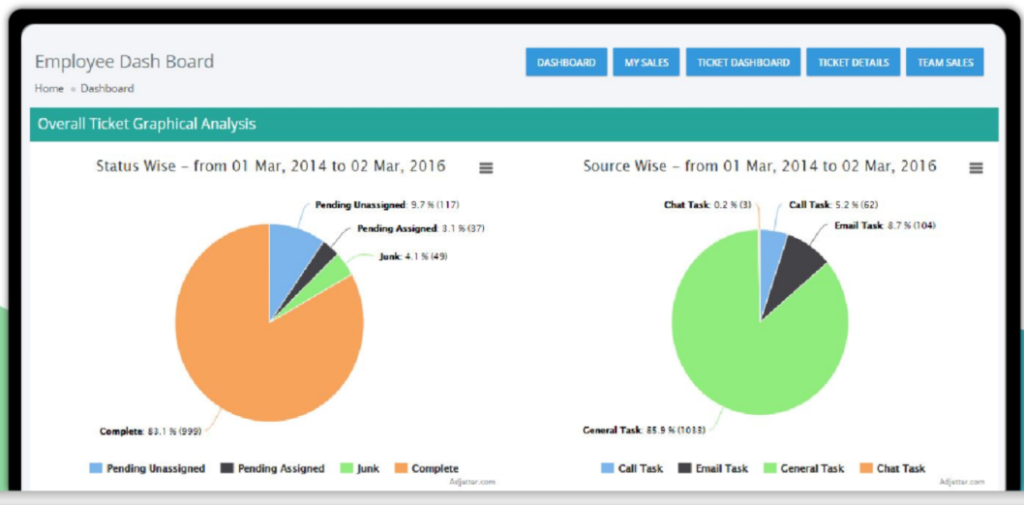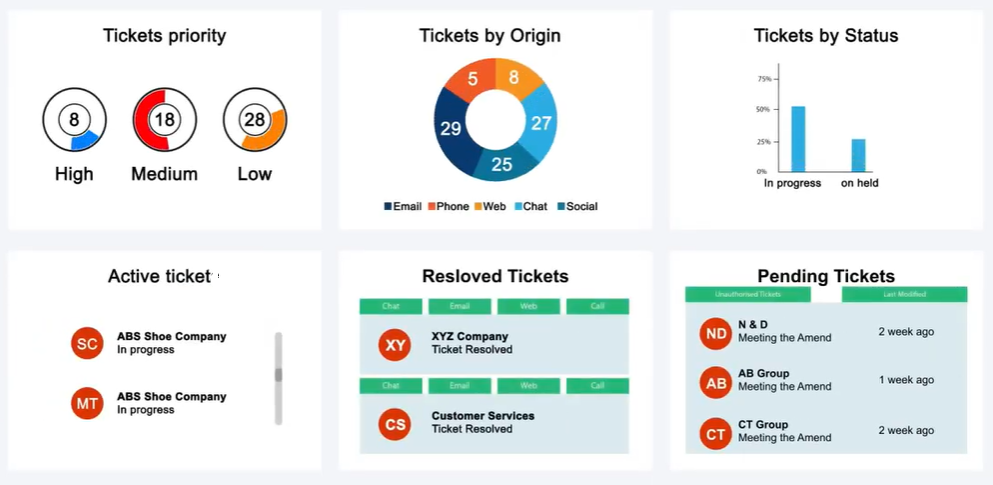There is no denying that your company is only as good as the decisions you make.
One bad move can earn you a wrecked ROI, unhappy customers, and negative service remarks on social media.
Further business-impacting repercussions needn’t be mentioned here as every businessman masterminding the digital economy knows it well enough.
- So how do you make infallible business decisions?
- In what ways can you build unfailing marketing campaigns that can draw many customers?
- Are there precise ways to ensure your contact center agents don’t keep customers on hold longer than the average hold time or leave any customers unanswered?
And, since the answers cannot be based on reflex, the only way forward is to have someone tell you exactly what needs to be done. Certainly, with adequate proof of structured data in real-time!
And that “someone” is Reporting and Analytics software solutions. It enables you to make actionable decisions not just for the moment, but as well as for the foreseeable market trends.
In essence, data-backed insights help you make the smartest business moves.
Read about,
How can I Improve my Call Center Reporting and Analytics?
Working to improve Reporting and Analytics at a detailed level makes it easy to stay ahead of the curve and build a brand that your customers idolize. Here are 10 ways to provide better contact center reporting and analytics.
1. Incorporate Customer Needs Within Business Strategies
Studying customer complaints and remarks might help you figure out what they expect. Solutions like text analytics can help you finely examine customer complaints. Reporting techniques must always be congruent with your main business strategy.
2. Ensure Constant Monitoring of Your Metrics
Monitor the success of your call center every day or frequently to avert negative trends before they worsen. CRMs like Kapture lets you schedule auto-report generations according to preset conditions.
3. Recognize your Current Performance Level
Determine your present position using the graphs and locate the places where you have been dragging. From there, you’ll be in a better position to make sensible decisions in the future.
4. Put in Place a Remedial Plan
Create a robust remedial actions strategy to tackle undesirable trends. When you observe one, notify your call center reporting team right away. Expend significant efforts in change management and communicate changes to your team promptly to drive them to align their performance for better KPIs.
5. Assemble the Best Team
An ideal candidate can produce exceptional outcomes with modest training. Candidates with excellent communication skills, a positive attitude, and a customer-centric vision are perfectly suitable.
6. Improve Staff Training
If you want to stay competitive, you must make training a continuous process rather than a one-time event. Keep an eye on current business trends and offer additional training programs to keep employees up to date on what’s going on.
7. Customize Reports Essential to your Business
Contact centers generate a lot of data, which is why it’s critical to tailor your reports to focus on the most crucial information. Make use of your contact center software’s customization capabilities to produce tailored reports based on purposes, departments, and groups.
8. Set up an Omnichannel System
The use of numerous platforms might exert a strain on the entire reporting process.
As a result, acquire a system that connects your Contact Center communications and reports so that you can instantly compare interactions across several channels.
To gain a complete picture of your business’s success, it is essential to collect data from all touchpoints along the customer journey and interaction.
Image: Kapture’s Employee Dashboard
9. Spend on the Best Contact Center Reporting Software
Software with limited integration capabilities and confusing interfaces can be a nightmare for the call center reporting team. Examine the available tools and select the best one for your company.
10. Ensure Reporting Security
A vast amount of personal information is managed by call centers. With stringent regulations and people concerned about their privacy, ensure that reports and reporting systems are designed by security standards.
What is Call Center Reporting?
The measurement and display of key performance indicators (KPIs) on call center operations is referred to as call center reporting.
When your contact center serves as a gold mine of valuable data, stump in the Reporting tools to extract comprehensible information that can help you fine-tune your business performance metrics.
Reporting systems translate feeds of raw data flowing into the contact center into critical performance metrics, allowing users to obtain the potential benefits of the contact center data.
Listed are common call center KPIs to keep track of:
- First Call Resolution (FCR)
It determines if a customer’s concern was handled the first time they called or if they had to call back several times.
- Agent Occupancy
The duration of your agents’ involvement in work-related activities is given by the occupancy rate.
- Adherence to Schedule
This metric measures the amount of time call center agents are accessible to receive customer calls.
- Abandoned Call Percentage
The abandoned call percentage is the percentage of tasks that a customer abandons before interacting with an agent or before finishing the intended action.
- Average Call Transfer Rate
This is a metric that tracks the number of calls that are transferred to another division, a manager, or a separate queue.
What is Call Center Analytics?
Let’s talk about analytics by comparing it to reporting.
In practice, they’re frequently used interchangeably. But here’s the key distinction.
Analytics is a means of studying your reports and data to uncover patterns and trends that reflect valuable actionable information.
Reporting solutions provide you with the information you need to begin asking questions, while analytics provides the data you need to find answers.
Although distinct, they work hand in hand. You won’t get one without the other if you use a savvy contact center solution.
The following is a list of call center analytics types that can assist businesses in improving their customer experiences.
- Speech analytics: This component is extremely important in voice-based call center processes as it assists agents in identifying, comprehending, and analyzing the customer’s requirements and insights during a conversation.
- Text analytics: It is similar to speech analytics in that it involves analyzing the customer’s needs through text or written documents.
- Cross-channel analytics: It enables you to identify and evaluate the various channels through which customers connect with your contact center to optimize customer interactions and plan staffing requirements.
- Predictive analytics: It helps you to make predictions of possible business opportunities or identify risks based on historical data and statistics.
How does Kapture CRM Help You to Better Report?
Kapture combines every functionality that can assist you in gaining insights from an ocean of data bits.
Image: A glimpse of Kapture’s dashboard features
Learn how Kapture stands out as an ideal solution with Call center dashboard capabilities that make reporting and analytics easier.
- Graphical Dashboard with a Simplified User Interface
Agents can access daily plans, view a summary of team performance, and many more functions in a dashboard with quick and easy drag and drop widgets.
- Custom Reporting
Create, retrieve, and share reports on important call metrics and agent productivity with a personalized view of the data for each user and role.
- Report Templates
Pre-built report templates assist supervisors and managers in swiftly creating performance reports. Pre-built reports are ideal for basic reporting requirements because they save time and are simple to use.
- Report Scheduler
With the help of the report scheduler, you may have reports distributed to decision-makers at a specific time and date. So, never miss out on creating a report.
- Remote Agent Monitoring
Use live dashboards to monitor the performance of your remote agents. Many contact centers have shifted to remote operation, with the manager and service employees working in separate physical locations. Kapture’s cross-device compatibility comes in handy here.
- Live Monitoring
Obtain real-time data on call center operations so that supervisors may detect changes and make required changes on time.
- Reminder Notifications
Agents can establish outbound call reminders so they never miss a call to a potential or prospective customer.
- Call History
Agents can access a customer’s whole call history to enter into meaningful and contextual conversations.
- SLA Monitoring
Prevent SLA breaches with live tracking and supervisor notification alerts. Establish multi-level escalation hierarchies to improve query resolutions.
- Call Recordings
Use voice logger to record all inbound and outbound calls for comprehensive training purposes.
- Agent Self-Assessment
Agents can monitor their progress to stay on track and meet their objectives.
- Data Consolidation
Smart contact center reporting solutions dissolve data silos and make data consolidation simple by incorporating all channels into the same solution.
Why is Reporting and Analytics Important in a Contact Center?
Reporting and Analytics provide real-time data to assist you to plan ahead of time and address any issues that are holding you behind. It is important to have a robust Reporting and Analytics feature because it lets you,
- Investigate operational efficiencies (such as response rate, resolution time, and agent performance).
- Learn how to use your findings to set realistic goals for your operations and team.
- Use professional reports and interactive dashboards to find insights that allow agents to anticipate customer requirements, recognize a lot of new trends, and resolve their concerns.
- Identify knowledge gaps and resolve issues through training sessions or other means.
- Track KPIs that are most important to your business to optimize contact center performance
- Provide contact center managers with the information they need to make smart judgments to improve service, save costs, and optimize procedures.
- Identify performance shortfalls by discovering the poor performing and habitually idle staff in your call centers and take action on them.
- Improves cross-organizational collaborations. The data displayed in a visual, intuitive, and interactive style dashboard is easy to analyze and share, thereby facilitating cross-departmental collaboration in no time.
Implement Call Center Reporting and Analytics solutions to streamline daily business operations, impress your customers, and outperform your competitors. To learn more, schedule a free demo of Kapture.
About the Author | |
 | Seema C Mohan |
| Seema C Mohan is passionate about all things XaaS and loves to write value-added content. She has been in Business Process Management in the past and has published technology articles in journals. | |
,
,
,
,
,
,
,
,
,
,
,
,
,










